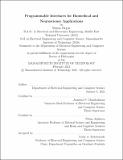| dc.contributor.advisor | Anantha P. Chandrakasan and Polina Anikeeva. | en_US |
| dc.contributor.author | Orguc, Sirma. | en_US |
| dc.contributor.other | Massachusetts Institute of Technology. Department of Electrical Engineering and Computer Science. | en_US |
| dc.date.accessioned | 2021-05-24T20:23:22Z | |
| dc.date.available | 2021-05-24T20:23:22Z | |
| dc.date.copyright | 2021 | en_US |
| dc.date.issued | 2021 | en_US |
| dc.identifier.uri | https://hdl.handle.net/1721.1/130769 | |
| dc.description | Thesis: Ph. D., Massachusetts Institute of Technology, Department of Electrical Engineering and Computer Science, September, February, 2021 | en_US |
| dc.description | Cataloged from the official PDF of thesis. | en_US |
| dc.description | Includes bibliographical references (pages 143-157). | en_US |
| dc.description.abstract | The rapidly changing fields of biomedical sciences and neuroscience increasingly adopt scientific and technological innovations to advance the diagnosis and treatment of disease. With the emergence of miniaturized and low-cost electronics, intelligent and computationally-efficient algorithms, together with new materials and fabrication techniques, an interdisciplinary approach becomes key in designing human-machine interface systems for these applications. This thesis explores the design of four programmable interface systems in this domain. First, we present an EMG-based facial gesture recognition platform. The system integrates a custom-designed EMG sensor interface for energy-efficient signal acquisition from a small footprint. The gesture recognition algorithm runs on the computer and achieves the classification of resting, clenching, chewing, and jaw opening activities in real-time. A wavelet-transform-based feature extraction improves the computational-efficiency. | en_US |
| dc.description.abstract | Next, we present an optoelectronic system for wireless neuromodulation during free behavior. The head-borne system interfaces with flexible, fiber-based, multifunctional brain probes that carry integrated [mu]LEDs for optical stimulation. The modular platform can also perform precise optical intensity control, in-vivo temperature sensing, and low-frequency neural recording when needed. The system uses BLE to communicate with the computer and can control multiple [mu]LEDs and multiple devices on different animals. Third, we present a strain-programmable artificial muscle, suitable for use in soft-robotics, neuroprosthetics, and smart-textiles applications. The fiber muscle is arbitrarily scalable and can be produced in kilometer-long scales. The strain-programmability allows precise control of the mechanical and electrical properties. It can carry 650 times of its weight, achieves a power-to-mass-ratio of 90 W/kg, and latency levels as low as 0.02 seconds. | en_US |
| dc.description.abstract | The conductive versions allow for direct piezoresistive feedback. Multiple fibers can be used in parallel to form bundle structures similar to human muscle. Finally, we present a biometric interface integrated into transparent, long-lasting respirators. The respirators are alternatives to commonly-used N95 masks. The electronic interface uses one of the filter insert locations to measure temperature, humidity, pressure, and air quality. The system uses BLE and sends real-time sensor information to a phone or a computer. The data can be used to inform the user regarding mask fit, fatigue, mask condition, and potential diagnostic information. | en_US |
| dc.description.statementofresponsibility | by Sirma Orguc. | en_US |
| dc.format.extent | 157 pages | en_US |
| dc.language.iso | eng | en_US |
| dc.publisher | Massachusetts Institute of Technology | en_US |
| dc.rights | MIT theses may be protected by copyright. Please reuse MIT thesis content according to the MIT Libraries Permissions Policy, which is available through the URL provided. | en_US |
| dc.rights.uri | http://dspace.mit.edu/handle/1721.1/7582 | en_US |
| dc.subject | Electrical Engineering and Computer Science. | en_US |
| dc.title | Programmable interfaces for biomedical and neuroscience applications | en_US |
| dc.type | Thesis | en_US |
| dc.description.degree | Ph. D. | en_US |
| dc.contributor.department | Massachusetts Institute of Technology. Department of Electrical Engineering and Computer Science | en_US |
| dc.identifier.oclc | 1252061550 | en_US |
| dc.description.collection | Ph.D. Massachusetts Institute of Technology, Department of Electrical Engineering and Computer Science | en_US |
| dspace.imported | 2021-05-24T20:23:22Z | en_US |
| mit.thesis.degree | Doctoral | en_US |
| mit.thesis.department | EECS | en_US |
